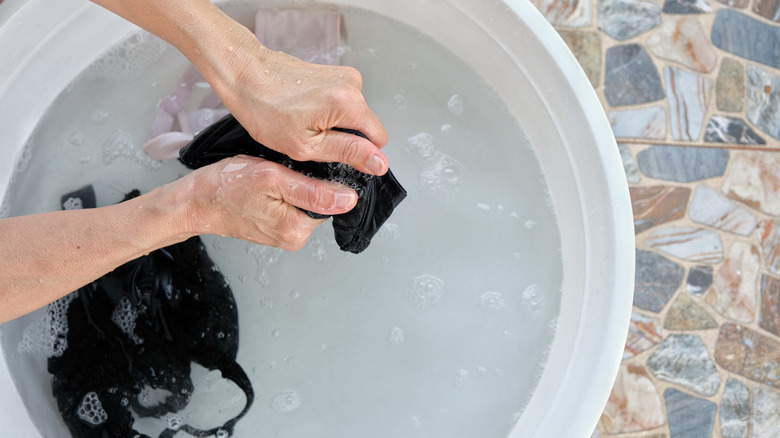Why You Should Think Twice Before Putting Your Swimsuit In The Washer
We may receive a commission on purchases made from links.
From bikinis and tankinis to one-pieces and halters, swimsuits come in all sorts of shapes and sizes. Beachwear has undergone quite a few changes in the last 300 years, traversing the spectrum from full-coverage linen bathing gowns in the 1700s to 21st-century micro tops. The early '40s saw the introduction of two-piece suits, and the first ever bikini popped up in 1946 thanks to the French designer Louis Réard (although many historians will note that the true origins of the bikini, like aqueducts and concrete, lie in ancient Rome). It wasn't until the '60s that this barely-there beach option became widely accepted in the United States.
Today's stretchy suits have a lot of benefits. They're figure-hugging and flattering – best of all, they dry a lot faster than 19th-century wool suits (yes, these were probably just as itchy as they sound). However, despite the impressive evolution of technology in the last few centuries, most suits still can't go in the washer. Here's why you should think twice before throwing your swimwear in with the rest of your laundry.
Hand washing is better for synthetic materials
After you get out of that pool, ocean, or pond you've been splashing in all day, give yourself a quick fresh water rinse. Not only is it important to get chlorine and bacteria off your skin and hair, but your suit can also benefit. If you can, avoid putting your swimwear in the washing machine. Normal cycles can stretch and fade synthetic-blended fabrics like nylon, spandex, and polyester, the materials that make up most bathing suits. When in doubt, check your garment's label to see what kind of cleaning method the brand advises.
So, how do you keep your swimsuit clean and odor-free without a machine? "If you're just rinsing with water and thinking that will be enough, it may not be," warns textile expert Preeti Arya in a conversation with Wirecutter. "Wash with a small quantity of detergent after every wear to remove any salts, minerals, and chemical deposits within the construction," she says, noting that oil-based sunscreens will easily stain most bathing suits. A gentle, activewear detergent should do the trick. If you find SPF residue on your favorite bikini, let your suit soak for half an hour, stirring it around occasionally and gently scrubbing affected areas. Finally, rinse underneath cool, soap-free water to get all that detergent out.
If you must machine wash, turn your appliance to the coldest setting, throw your suit into a washing bag meant for bras (see here on Amazon), and throw it in with similar fabrics.
Whatever you do, don't use a dryer
What happens when you put a bra in the dryer? It warps. Machine drying is a no-no when it comes to swimsuits, too. Although a quick turnaround might sound convenient now, it'll be damaging in the long run. The intense heat from a cycle can interfere with your suit's stretchiness and overall fit, and wearing a bikini that no longer clasps in all the right places can lead to a regrettable swimsuit disaster.
Letting your suit air dry under the sun may sound like the next best solution, but this can also lead to long-term damage. "Always dry in the shade, rather than direct sunlight, to stop the swimwear from fading," swim label Fae founder Bianca Bennetts told Nylon. Additionally, instead of hanging your stylish suit up on a clothesline, let it dry on a flat surface like a table, bed, or drying rack. Both gravity and clothes pins can stretch out the spandex. If you're looking to speed up the process, prop it up in front of a fan instead.
The bottom line? Swimsuit material is moldable, and you'll need to learn how to care for it correctly in order to preserve its shape. When in doubt, forgo modern technology and let your hands do the work.


